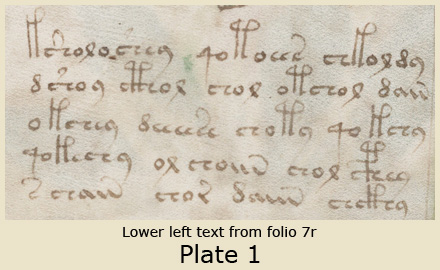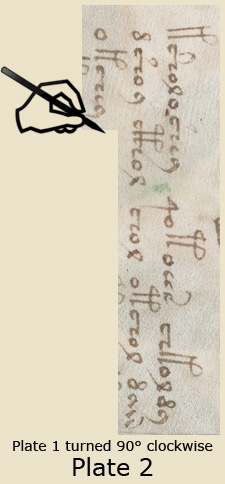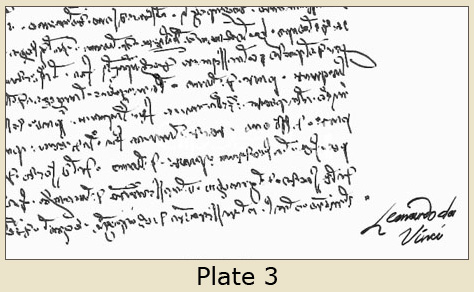The Voynich Manuscript’s Script and Code

In my previous article I showed that Leonardo da Vinci’s handwriting and the Voynich Manuscript’s script are very similar, adding additional credence to my theory that Leonardo was the author of the VM. Since the VM was written from left to right and from top to bottom, it is generally assumed that the author was right-handed, or as I assumed, a lefty trained to write with his right hand. Recently I examined individual letters and symbols from the VM and came to the conclusion that Leonardo wrote the manuscript using his left hand(i). The manuscript was written with a quill pen, resulting in thicker and darker ink at the starting point of a letter/symbol and the ink tailing off at the end. The chart below shows some letters/symbols from a section of Folio 8r, Plate1. The red arrow shows the starting point and direction of the pen when these letters were formed. Their formation is compared to that generally used by right-handed writers.
| Letter | Symbol | VM Script | Right-hand Script(ii) |
| a |  | Written from right to left. Backhand slope indicates lefty. | Written from left to right. |
| o |  | Written clockwise. | Written counter clockwise. |
| Inverted gamma |  | Written from bottom right to upper left. | Written from left to right. |
| r |  | Written as arrow indicates. Backhand slope indicates lefty(iii). | Written from the top down. |
| 8 |  | Written from the bottom. | Written from the top. |
| c |  | Written from bottom right to left. | Written from the top down. |
How did a lefthander write over 200 pages without smearing a single letter? One possibility is crab claw writing, where the author holds his left hand at right angles above the line and writes from above. Many lefties write this way, but it can lead to smeared ink, prevents the writer from seeing what was just written, and is uncomfortable.

An alternative method is to turn the parchment 90 degrees clockwise and write perpendicular to the line.
| Consider this VM glyph: |  |
The best way for a left hand writer to write it without smearing the ink is to turn the parchment clockwise through a 90 degree angle and write the glyph downwards: |  |
This avoids smudging the ink and allows the lefty to see what he has written. This is the hardest method of left-handed handwriting to master, but is superior to other methods for producing a legible script, Plate 2.

Leonardo is best known for his left-handed mirror image writing. Consider Plate 3, an example of his mirror image writing with a signature written from left to right at the bottom of the page. Did he write this signature with his right hand or his left hand? Using his right hand may have required him to change pens. The tip of a quill pen that was used for mirror image writing may, due to wear, be unsuitable for writing with the right hand. A simpler solution is that he turned the page clockwise through 90 degrees and signed his name with his left hand. It is not possible to verify either suggestion but a master draftsman like Leonardo, even when he was a child, would have had no problem writing from left to right this way.
In the 21st century writing left handed is well accepted, however in the 15th century it was a stigma—lefties were called southpaws; the devil was considered to be left handed—so it is surprising that Leonardo was not trained to write with his right hand. Being illegitimate prevented him from becoming a notary like his father or a candidate for other professional occupations. As a result his schooling was limited, he never learnt Latin, his notebooks reveal arithmetic errors and he lamented that he was not a man of letters. It is easy to believe that his father, observing his artistic talent, coupled with his ability to write mirror image script, may have considered that he could be trained to be an engraver or carver of woodblocks for printing multiple copies of books(vi). He may therefore have encouraged his son to write and sketch with his left hand. The printing press was invented in 1456 and the first printing press came to Italy in 1465. Mirror image woodblock letters were no longer required.
Captain Preston Currier, at a symposium in 1976, proposed the theory that the VM was written in two different languages, by as many as four different hands. His theory was based on a superficial examination of the script and the frequency of a few short words in the various folios. A number of investigators(vii) do not accept the multiple hand theory and believe that a single individual wrote the VM. The frequency differences of a few words should not be ignored. Leonardo probably spent a number of years drawing and writing in this little book, some drawings are much better than others. The frequency differences in a few words may reflect inconsistencies in his spelling and the use of abbreviations, or he may have been in a hurry and abbreviated words because he was making notes that he did not expect anyone else to read. He may have written the VM the way young people today e-mail and text message; they leave out vowels and shorten words, with the result that their communications appear to be written in an artificial language.
A number of very qualified code breakers like William F. Friedman, who deciphered the Japanese purple code during World War II, and computer experts have attempted to decipher the VM, but without success. The question we should ask is why did all these very competent code breakers fail? One theory put forward by Gordon Rudd, is that the manuscript is a fake and the writing meaningless. I believe that the VM has resisted being deciphered because like the genetic code, its code is degenerate. In the case of the genetic code, each protein amino acids may be selected by one or several codons, thus preventing some mutations from becoming lethal. If the code used for the VM is due to different letter sequences for the same word or the same sequence for two or more different words; i.e. an anagram of the word, this redundancy may be the reason nobody has been able to decipher the manuscript. An anagram-based code would be useless for sending secret messages, but if used for personal notes, it need not be a disadvantage and would ensure that no one could easily read what you had written. Leonardo was very secretive and wrote his later notebooks using mirror image writing, a natural way for him to write but not easy to read without the aid of a mirror. He used anagrams to conceal the names of his friends(viii).
In 2009 I wrote an article(ix) that described the decoding of a number of words from Folios 99-102 of the VM using Italian as the basic language, a modified EVA alphabet and anagrams for the code. In this paper I used as a crib the single sequence of letters next to the plant drawings. By identifying some plants and using the EVA alphabet, I was able to decode the anagrams associated with each plant, verifying that the language used was Italian and that anagrams were used for the code. For those plants that I recognized and knew the common Italian name, the method was successful. In a few cases I had to modify the EVA alphabet. Once I made a change to this alphabet, I did not change it again. I was unable to decode all the names, either due to my inability to identify the plant or because I did not know the colloquial, medieval, Italian name for the plant. Latin names were not used.
Champillion used a similar procedure to decipher Egyptian hieroglyphics. He recognized that the drawing of the sun god Ra represented the sound ‘ra’. This was the basis for his crib and enabled him to decipher the Rosetta stone. The approach I used to decode several words in the VM, did not use phonetics but unraveling the anagram next to a plant drawing to produce a modified EVA alphabet that corresponded to the Latin alphabet. I used this modified EVA alphabet to decipher selected passages from the VM(x). This work received mixed approval, but I noticed recently that at least three different investigators also believe that anagrams are the solution to the VM code. I will be interested to see how closely the results match when several investigators decode the same passage from the VM. A single sequence of letters could represent one or more different words. I gave up decoding the VM mainly due to my lack of training in Italian and the tedium in unraveling anagrams. Recently some questionable proposals have been suggested for either the origin, language or deciphering of the VM. My anagram decoding work can be reviewed in these two articles: The Voynich Manuscript Decoded? and The Voynich Manuscript Decoded? – Part II. Anagrams are a simple and fast coding method for a book that contains over 200 pages(xi).
- The first letter of the plant name would indicate the letter from the movable disk to be placed under the A of the stationary disk.
- A number encountered in the text would indicate that the movable disk should be turned to place the second letter of the plant name under the letter A of the stationary disk.
- Coding would continue in this fashion until the end of the page.
- On the next page the above procedure is repeated but using the plant name of the new drawing.
This method of coding may explain the frequency of ‘8am’ in some folios and ‘am’ in others. The number 8 may indicate the need to change the position of the movable disk. The pair of letters ‘am’ may in some cases represent the word ‘se’ the Italian word for ‘if’, the letter ‘S’ having been placed under the letter ‘A’ of the stationary disk, the letter ‘E’ would be under the letter ‘M’. The letter ‘S’ would be present in both plant names. A document coded using this method would not be easy to decipher and would not require the coder and the recipient to have a one-time pad. It has the disadvantage of being very slow to encrypt and equally slow to decrypt.
Leon Batista Alberti described the cipher disk in 1467. He came from a noble Florentine family and was the architect for the upper part of a church in Florence, Santa Maria Novella, from 1456 until shortly before his death in 1471. Leonardo was working in Florence at Verrocchio’s studio from 1468 until about 1480 and may well have known Alberti and made an Alberti disk. Leonardo may have added coded text to the botanical drawings in the VM in order to hide his notes on experiments in alchemy and similar pursuits.
I have not attempted to decipher the VM using this coding method. It requires the use of a suitable computer program and the medieval Italian names of the plant drawings. I hope someone will check it out. Very dark secrets may be hidden within the VM for anyone to go to this amount of trouble. Personally I believe in Occam’s razor and consider anagrams as the simpler solution to the VM’s code, after all I have shown that the method works!
- ↑ back I thank Karen Sherwood for this idea.
- ↑ back Letter formation charts http://www.hwtears.com/files/Letter%20Formation%20Charts.pdf
- ↑ back Varieties of left hand writing http://www.musanim.com/mam/lefthand.htm
- ↑ back Letter formation charts http://www.hwtears.com/files/Letter%20Formation%20Charts.pdf
- ↑ back Jan B. Hurych, How many hands wrote the Voynich manuscript, http://hurontaria.baf.cz/CVM/a17.htm
- ↑ back Joe Nickell http://www.csicop.org/si/show/deciphering_da_vincis_real_codes/
-
↑ back
Rene Zandberger, The Voynich Manuscript, for references, http://www.voynich.nu/
Jan B. Hurych, How many hands wrote the Voynich manuscript, http://hurontaria.baf.cz/CVM/a17.htm - ↑ back Ross King, The Last Supper.
- ↑ back Edith Sherwood, The Voynich Manuscript decoded, http://www.edithsherwood.com/voynich_decoded/
- ↑ back Edith Sherwood, The Voynich Manuscript decoded Part II, http://www.edithsherwood.com/voynich_decoded_part2/index.php
- ↑ back I want to warn anyone trying to use my modified EVA alphabet that it is incomplete and requires more work, particularly with respect to some symbols and the meaning of the variety of large letters resembling a capital P. Unlike the Roman alphabet with 26 letters, the Italian alphabet has only 21, the letters J,K,W,X,Y are used for loan words only and therefore may not be part of the EVA alphabet.
- ↑ back I thank Kevin Sherwood for this suggestion.
Acknowledgements: I would like to thank my daughter Erica for all her hard work in preparing my articles for posting on the internet and for maintaining my very attractive web site.